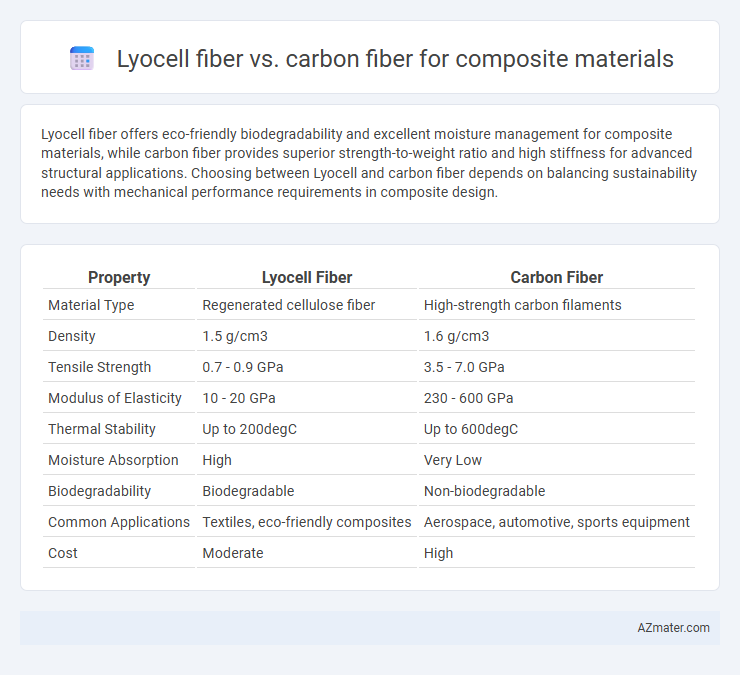Lyocell fiber offers eco-friendly biodegradability and excellent moisture management for composite materials, while carbon fiber provides superior strength-to-weight ratio and high stiffness for advanced structural applications. Choosing between Lyocell and carbon fiber depends on balancing sustainability needs with mechanical performance requirements in composite design.
Table of Comparison
| Property | Lyocell Fiber | Carbon Fiber |
|---|---|---|
| Material Type | Regenerated cellulose fiber | High-strength carbon filaments |
| Density | 1.5 g/cm3 | 1.6 g/cm3 |
| Tensile Strength | 0.7 - 0.9 GPa | 3.5 - 7.0 GPa |
| Modulus of Elasticity | 10 - 20 GPa | 230 - 600 GPa |
| Thermal Stability | Up to 200degC | Up to 600degC |
| Moisture Absorption | High | Very Low |
| Biodegradability | Biodegradable | Non-biodegradable |
| Common Applications | Textiles, eco-friendly composites | Aerospace, automotive, sports equipment |
| Cost | Moderate | High |
Introduction to Composite Materials
Composite materials combine two or more constituent materials with distinct physical or chemical properties to create a superior product. Lyocell fiber, derived from cellulose, offers sustainable, biodegradable reinforcement with high tensile strength and excellent moisture management, enhancing composites' environmental profile. Carbon fiber provides exceptional stiffness, strength, and lightweight properties, making it ideal for high-performance composite applications in aerospace and automotive industries.
Overview of Lyocell Fiber
Lyocell fiber is a biodegradable regenerated cellulose fiber known for its excellent tensile strength, moisture absorption, and eco-friendly production process, making it a sustainable alternative in composite materials. Unlike carbon fiber, which offers superior stiffness and high strength-to-weight ratio, lyocell enhances the composite's flexibility, impact resistance, and comfort in applications requiring lightweight and durable materials. Its renewable nature and lower environmental impact position lyocell as a promising option for green composite manufacturing.
Understanding Carbon Fiber
Carbon fiber is a high-strength, lightweight composite material composed of thin, strong crystalline filaments of carbon bonded together with a polymer matrix, offering superior stiffness and tensile strength compared to Lyocell fiber. Its exceptional mechanical properties, thermal stability, and chemical resistance make carbon fiber ideal for aerospace, automotive, and sporting goods applications where performance and durability are critical. While Lyocell fiber is biodegradable and derived from cellulose, it lacks the structural strength and rigidity provided by carbon fiber in composite materials.
Mechanical Properties Comparison
Lyocell fiber exhibits excellent tensile strength and elongation, making it highly flexible and impact-resistant for composite material applications. Carbon fiber outperforms Lyocell in stiffness and tensile modulus, delivering superior rigidity and load-bearing capacity but with lower elongation at break. The mechanical property contrast positions Lyocell as ideal for lightweight, flexible composites, while carbon fiber suits high-performance, mechanically demanding structures.
Environmental Impact: Lyocell vs Carbon Fiber
Lyocell fiber exhibits superior environmental impact compared to carbon fiber due to its biodegradability and sustainable production from wood pulp using a closed-loop solvent process that recycles 99% of chemicals. In contrast, carbon fiber manufacturing involves high energy consumption and emits significant greenhouse gases, contributing to a larger carbon footprint. Lyocell supports circular economy principles, while carbon fiber composites pose recycling challenges and persistence in landfills.
Processing and Manufacturing Differences
Lyocell fiber is produced through a closed-loop solvent spinning process that uses non-toxic solvents, resulting in low environmental impact and high fiber purity, while carbon fiber manufacturing involves complex precursor stabilization, carbonization, and surface treatment steps requiring high temperature and energy consumption. Lyocell fibers are typically processed through conventional textile methods and can be easily integrated into composites using resin infusion or compression molding, whereas carbon fiber composites require precise control of curing cycles and often employ advanced techniques like autoclaving to achieve superior mechanical properties. The manufacturing of Lyocell-based composites emphasizes biodegradability and renewability, contrasting with the emphasis on strength-to-weight ratio and thermal resistance in carbon fiber composite production.
Cost Analysis and Economic Considerations
Lyocell fiber offers a cost-effective alternative to carbon fiber in composite materials due to its lower raw material expenses and simpler processing requirements, making it attractive for large-scale, budget-sensitive applications. Carbon fiber composites, while delivering superior strength-to-weight ratios and durability, incur significantly higher costs stemming from complex manufacturing processes and expensive precursor materials like polyacrylonitrile (PAN). Economic considerations often favor Lyocell fibers in industries prioritizing sustainability and affordability, whereas carbon fiber remains preferred in aerospace and automotive sectors where performance justifies the premium.
Applications in Industry and Engineering
Lyocell fiber is increasingly used in automotive and aerospace industries for lightweight, biodegradable composite materials due to its high tensile strength and eco-friendly properties. Carbon fiber dominates high-performance engineering fields like aerospace, automotive, and sports equipment, offering exceptional stiffness, strength-to-weight ratio, and thermal resistance. Combining Lyocell and carbon fibers in hybrid composites optimizes mechanical performance while reducing environmental impact in advanced industrial applications.
Strengths and Limitations of Each Fiber
Lyocell fiber offers excellent biodegradability, high moisture absorption, and good tensile strength, making it ideal for eco-friendly composite materials with moderate load requirements. Carbon fiber provides superior strength-to-weight ratio, exceptional stiffness, and high fatigue resistance, suitable for high-performance aerospace and automotive applications. However, Lyocell fibers suffer from lower impact resistance and thermal stability compared to carbon fiber, which is costly and vulnerable to brittle failure under extreme impact.
Future Trends in Composite Fiber Technology
Lyocell fiber and carbon fiber represent contrasting futures in composite material technology, with Lyocell offering sustainable, biodegradable options derived from wood pulp and carbon fiber delivering high strength-to-weight ratios and exceptional stiffness for advanced engineering applications. Emerging trends indicate increasing hybridization, combining Lyocell's environmental benefits with carbon fiber's mechanical performance to achieve composites with enhanced durability and reduced ecological impact. Advances in nanotechnology and bio-based resin systems are expected to further optimize both fibers, driving innovation in lightweight, high-performance composites for automotive, aerospace, and construction industries.

Infographic: Lyocell fiber vs Carbon fiber for Composite material
 azmater.com
azmater.com